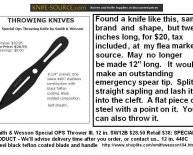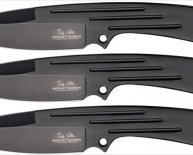
Katana Blades
 For first time buyers it may not be known that there are various types of katana swords to choose from. I’m not talking about variances in their external cosmetics but instead in their composition and blade cut. The strength, weight, and cutting ability all comes down to the design, material, and forge method used to create the katana.
For first time buyers it may not be known that there are various types of katana swords to choose from. I’m not talking about variances in their external cosmetics but instead in their composition and blade cut. The strength, weight, and cutting ability all comes down to the design, material, and forge method used to create the katana.
Before you decide to get a sword you should make yourself aware of the various types of katana swords and which may be best for the application you intend to use it for.
The Various Types of Katana Swords
Step one is determining the type of katana sword you’d like to get, which you most likely will be faced with any of the following metal types:
Folded Steel (Tamahagane)
This blade has a high carbon composition that is strengthened through its forging method. This is the traditional method used in forging katanas in Japanese culture many years ago. The term “Tamahagane” means precious steel and is created from an iron sand composition.
The process for creating these types of katana swords is very time consuming and involves creating the tamahagane in a large clay mold called a tatara. The sword-smith will repeatedly heat and hammer the sword to remove any impurities that may exist within the material. When he or she is finished they will have an exceptionally durable sword with a beautiful blade pattern giving off a nice sheen.
The age of the steel used also plays a role in the durability of the blade. Katanas made with older steel have a higher concentration of oxygen in them which means that during the forging process the oxidized portions of the blade will be easier to stretch which means that the hammering process will be more effective in removing these impurities leaving you with a sturdy and dependable katana sword.
These swords are usually the most costly due to the extensive time involved in making them. The image below is an example of what is considered one of the highest quality Tamahagane katanas made in modern time- the Taka Katana.
Tamahagane katanas are best for those who have been practicing martial arts for quite some time and have a large amount of disposable income they’re willing to spend on a sword. You can find folded steel blades at reasonable prices though, just do some searching around (I’ll actually recommend some sites later in this Katana Readiness Guide where you can buy a katana from a trusted dealer).
If you are looking to find a strong katana to use for cutting then this blade type would be most preferable. Tamahagane katanas are also highly sought by sword collectors as well.
Usually swords that have taken longer to forge will be of higher quality since there are multiple iterations of smelting, folding, and hammering, so look for information around the forge process. Swords of Northshire’s custom katanas usually indicate the forging times on each sword.
Stainless Steel
Stainless steel blades are more aesthetically appealing than useful in dojo fighting, therefore are primarily used as show pieces instead of functional swords. These swords molecular composition isn’t as durable as the folded steel or the carbon steel. This in return means that the blade will be more brittle and can break with hard impacts.
Since the geometry of the blades isn’t as well designed there are issues with poor tang construction, this can make swinging the sword unbalanced and potentially dangerous. Additionally most stainless steel blades aren’t put through the same rigorous heat treatment process that other types of katana swords are put through which strengthens the material.
My personal preference is that if you are looking for a katana that you can actually use then you should avoid any stainless steel blades. Due to their high chromium composition (visually enhances the sword) they do make nice wall-hangers if you are decorating an apartment or your dojo though.
What these blades do have going for them aside from their visual appeal is that due to the chromium element they are resistant to rust and corrosion.
Carbon Steel
When looking for a combination of quality and price the high carbon steel katanas seem to be most preferable and common in the market. These types of katana swords are usually favored due to their strong durability as a result of their chemical makeup. High carbon steel blades lack the chronium component that you’d find in stainless steel which does allow for the carbon blades to be stronger yet on the flip side they are susceptible to corrosion because of this missing component.
Despite their name, carbon steel swords do have less carbon than typical stainless steel swords do which allows them to be more compatible with other metals. Carbon steel is much harder than stainless which creates the ability to hold a sharper and more acute edge. As a result, they are quicker to sharpen and can achieve a sharper edge than the stainless do.
As the percentage of carbon in the blade rises the steel has the ability to become more durable through heat treating; however, it also becomes less pliable. Additionally the higher the carbon content the lower the melting point is. So the higher the carbon content the stronger and less pliable the blade is, the lower the carbon content the softer and more pliable the blade is.
Within the carbon steel swords there are numerous types of metal grades, far more than I will take the time to mention and put you through the long, boring definition of the slight variances in each. Instead I’ll let you know the most common high carbon steel blades you’ll probably come across in the katana market.


















